Slow Cognition: The "Activity - Opportunity" Thematic Dialogue

The Journey of Making the Thematic Engagement Framework
On Sept 15, 2022, I launched the Thematic Engagement Toolkit (v1.0) which is for understanding knowledge engagement, thematic conversation, controversy, thematic reflection, etc. The toolkit refers to a dialogue between the following two knowledge frameworks:
- The Themes of Practice Approach (2019, 2021)
- The Project Engagement Approach (2021, 2022)
In fact, this is a milestone in my journey of "Activity - Opportunity" Thematic Dialogue.
Today I will use the “WXMY” Diagram to run a case study in order to develop a method for Mapping Thematic Dialogue.
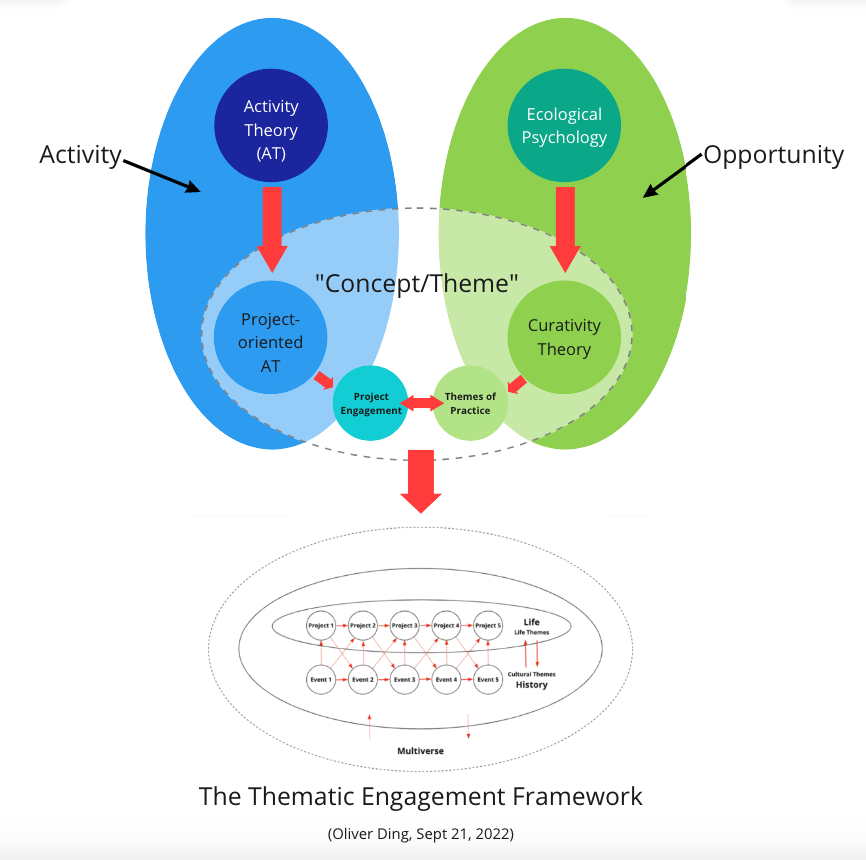
In the past several years, I worked on connecting THEORY and PRACTICE. Since I didn't work on only one theory, there was a challenge for me. I had to maintain the boundary between one theory and the others. For example, Activity Theory and Ecological Psychology.
However, I found the zone of boundary is a great creative space for developing new ideas. Sometimes, I can find similarities between these two theories.
Eventually, I found a new way to develop a thematic dialogue between two different theories.
The above diagram represents the process of the journey of making the Thematic Engagement framework by running a thematic dialogue between Activity Theory and Ecological Psychology.
What's my strategy behind the process?
- Move from "Theory" to "Thematic Space"
- Move from "User" to "Maker"
- Switch between Host and Guest
- Close A Thematic Dialogue
This article will unpack these strategies and develop a framework for Thematic Dialogue.
Contents
- Move from "Theory" to "Thematic Space"
- Move from "User" to "Maker"
- Making Project-oriented Activity Theory
- Making Curativity Theory
- Switch between Host and Guest
- Guests: "Affordance" and "Ecological Zone"
- Guests: "Concept" and "Formation of Concepts"
- Second-wave Development
- "Themes of Practice" in 2021
- "Project Engagement" in 2022
- Close A Thematic Dialogue
1. Move from "Theory" to "Thematic Space"
I have over twenty years of work experience which can be divided into three stages: the creative stage, strategic stage, and innovative stage. At the creative stage, I worked for the advertising and media industry as a creative copywriter and designer. At the strategic state, I worked for pre-IPO stage enterprises as a business strategist and fundraising consultant. At the innovative stage, I worked on making brand new digital tools and platforms as a researcher and designer.
Before 2014, I spent most of my spare time on digital nonprofit communities as a digital activist. From 2014 to 2015, I transformed my focus from nonprofit activities to theoretical learning. Since then, I have been spending most of my spare time learning ecological psychology, creativity research, and other related subjects.
2014–2020: Ecological Psychology and Creativity Research
2014–2018: Action Science, Activity Theory and Cognitive Science
2018–2019: Practice Theory, HCI, Strategy and Work
2020: Social Theory, Social Media, Information Systems and Platform
I also use "Thematic Space" to build my personal epistemological framework. See the diagram below. You can find more details in D as Diagramming: The Mind as Play Metaphor.

The framework is formed by four thematic spaces:
- The “Architecture” Thematic Space
- The “Relevance” Thematic Space
- The “Activity” Thematic Space
- The “Opportunity” Thematic Space
What's the difference between a Theory and a Thematic Space? See the diagram below.
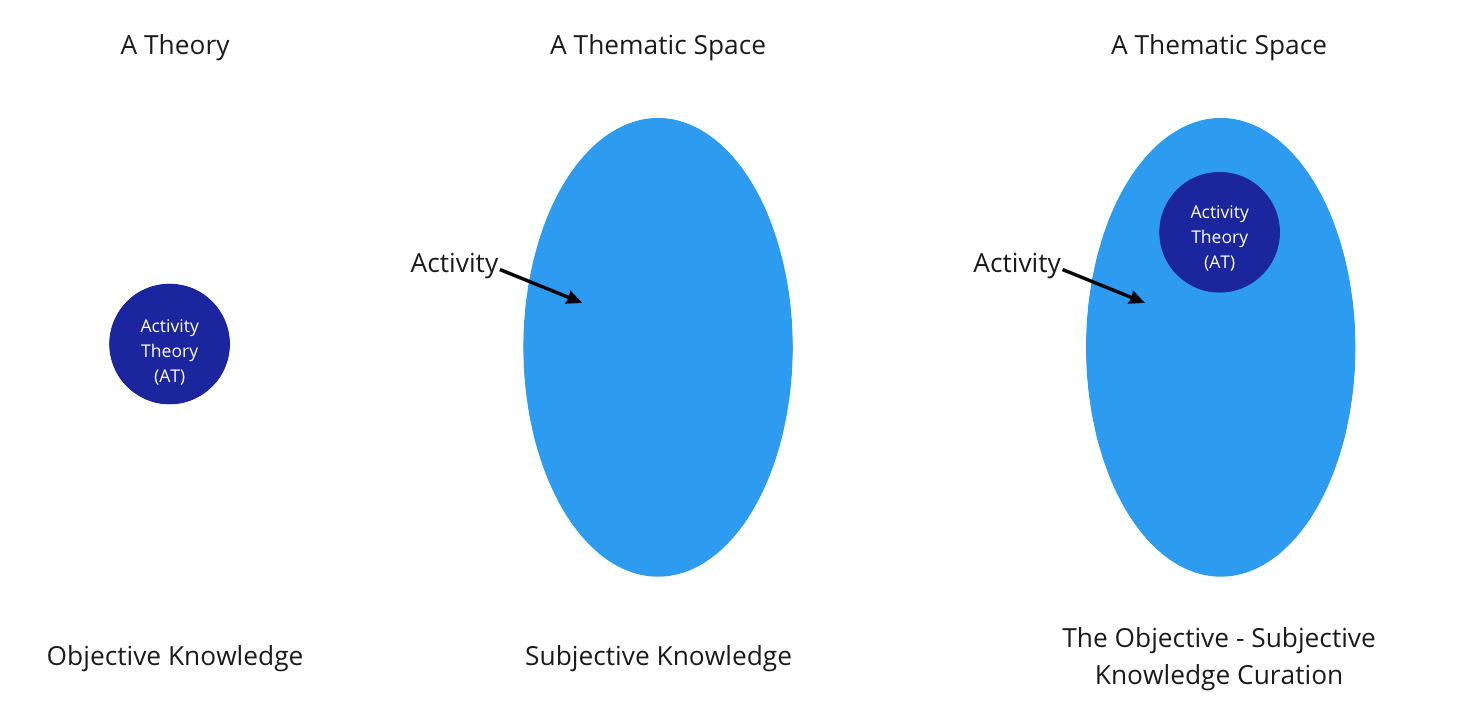
The major difference between a Theory and a Thematic Space is that the former refers to Objective Knowledge while the latter refers to a space for the Objective - Subjective Knowledge Curation.
For example, Activity Theory or the “Cultural-historical activity theory (CHAT)” is an interdisciplinary philosophical framework for studying both individual and social aspects of human behavior. It refers to an established academic field, a theoretical tradition, and Objective Knowledge.
According to Kaptelinin & Nardi (2012), “The immediate conceptual origins of activity can be found in Russian/Soviet psychology of the 1920s and 1930s. During that time theoretical explorations in Russian psychology were heavily influenced by Marxist philosophy… Leontiev’s activity theory emerged as an outgrowth of the sociocultural perspective. The theory employs a number of ideas developed by Lev Vygotsky, Leontiev’s mentor and friend. It is also strongly influenced by the work of Sergei Rubinshtein, a major figure in Russian psychology and a long-time colleague of Leontiev.”(p.13–14) You can find more details in The Landscape of Activity Theory and CHAT.
For my journey of "Activity - Opportunity" Thematic Dialogue, my "Activity" Thematic Space refers to a cognitive space about the theme of "Activity".
The “Activity” Thematic Space refers to Activity Theory and Social Practice Theories in general. Its unit of analysis is not individual behavior, it is not macro social structure or cultural meaning either. Since 2001, a group of philosophers, sociologists, and scientists have rediscovered the practice perspective and used it as a lens to explore and examine the role of practices in human activity. Researchers called it The Practice Turn in Contemporary Theory. As Schatzki pointed out, “there is no unified practice approach”(2001, p.2). Davide Nicolini used a toolkit to introduce six different ways of theorizing practice in his 2013 book Practice Theory, Work, & Organization. Activity Theory is considered one of six social practice theoretical approaches.
Though I read books and papers about Activity Theory and Social Practice Theories, most of my projects are related to Activity Theory.

Inspired by Ecological Psychology, I worked on developing a new theoretical approach called the Ecological Practice approach.
The Ecological Practice approach is inspired by ecological psychology, but it also developed its own theoretical concepts such as Attachance, Supportance, Curativity, Infoniche, Lifeway/Lifeform/Lifesystem, etc. I started from the concept of Affordance and went beyond the field of visual perception. You can find more details in The Development of Ecological Practice Approach.
I used the term "Opportunity" to name a thematic space that contains Ecological Psychology, the Ecological Practice approach, and related ideas such as Affordances, Opportunities, Possible Actions, Possible Practices, and my own ideas. You can find more details in D as Diagramming: The Opportunity Formula and An Integrated Framework for Studying Knowledge Diagrams (Part 4A).

A Thematic Space is a space for the Objective - Subjective Knowledge Curation. I used the above "Knowledge Discovery" canvas for mapping the process with eight dimensions.
For example, the "Concepts — Notions" Dimension. I consider Concepts in outer space and Notions in inner space. For thematic space, the term Notions is used for a person’s own understanding of Knowledge Concepts. Thus, Notions refer to ideas, questions, and insights about existing knowledge concepts.

The A1 mapping clue is “Object — Objective/Object” which was introduced in the previous article. You can find more details here.
The strategy of "Move from Theory to Thematic Space" emphasizes the active attitude of adult lifelong learning and development. This is the starting point of the journey of knowledge engagement.
2. Move from "User" to "Maker"
In an analysis of the use of activity theory in HCI research, Bonnie Nardi (2016) and her colleagues collect 109 HCI activity theory papers and find scholars use five strategies in their research work to make use of activity theory:
(1) an object of analysis, focusing on activity theory per se (5 papers);
(2) a conceptual tool for design, applying activity theory to support design (17 papers);
(3) a meta-tool, using activity theory as a guide for developing a new analytical tool (16 papers);
(4) a tool for conceptual analysis, using activity theory for predominantly conceptual analysis of HCI (30 papers); and
(5) a tool for empirical analysis, using activity theory to guide and support empirical analyses of HCI phenomena. (note 3, Making HCI theory work: an analysis of the use of activity theory in HCI research).
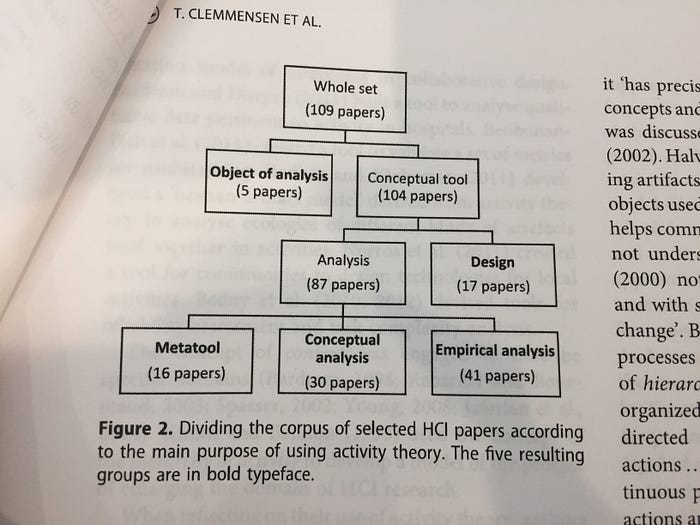
At the end of the paper, they ask the following essential question:
Should HCI researchers be considered theory-makers or theory users?
They believe HCI researchers can be both theory-makers and theory-users. They compare the IS (Information Systems) researchers with HCI researchers in the paper: “Kjærgaard and Vendelø (2015) found that IS researchers studying sensemaking theory often used it without explaining it or providing substantial theoretical background or discussion. They concluded that IS research is mainly concerned with empirical phenomena, pays little attention to theory construction and development, and that therefore IS is less likely to gain recognition as a reference discipline for other disciplines. ”
Kjærgaard and Vendelø said in their paper, “…the success and legitimacy of a young academic field depends on its ability to convince more established fields that it has a contribution to make. The reference discipline debate addresses the issue of legitimacy building by a young field, as it examines whether other fields have been convinced that the knowledge it produces is worth referencing.”
Here we see an important structure of “domain-theory-people”. Any domain can be seen as a platform for career development for people. For academic domains, if people take challenges of building high-level theories, then the domain they belong to will become a reference discipline that can influence other domains. As they say, the HCI domain is in this situation:
“In contrast, there are reasons to believe that HCI is in a better situation when it comes to providing theoretical influence on other disciplines. There are indications that HCI acts as a reference discipline; for example, the classic activity theory HCI text Context and Consciousness (Nardi 1996) has been widely cited outside HCI. Instead of theory use as passive consumption of a theory ‘product’, we found numerous cases of theory development. These papers would, for example, alert the reader in the title, abstract, and keywords that the paper is about activity theory; cite the reference HCI activity theory texts; use activity theory deeply and in a substantial way; and reflect core HCI activity theory concerns. We believe that HCI researchers can be described as not only ‘theory users’, but also as ‘theory-makers’.”
For the Objective - Subjective Knowledge Curation, the distinction between "User" and "Maker" can refer to two different learning approaches: Knowledge Transfer and Knowledge Discovery. While the "User" of theoretical knowledge adopts the knowledge transfer approach and just uses it correctly, the "Maker" of theoretical knowledge runs the knowledge discovery activity while making something new.
A "Maker" can learn theory in her spare time. She can join a project of editing a book about a theory and design a cover and diagram for the book. She also can design a website to collect theoretical papers about a special theme. She also can make a speech and introduce a theory to her peers.
If you read my journey of "Engaging with Activity Theory", you can find my moves between "User" and "Maker". For example, I run the Activity U project in 2020 and wrote a series of articles about Activity Theory.
3. Making Project-oriented Activity Theory
A great by-product of the Activity U project is the book Project-oriented Activity Theory (draft). In the beginning, I just wanted to test a diagram. Later, I found Andy Blunden’s account “An Interdisciplinary Theory of Activity” which suggests the notion of “Project as a unit of Activity”.
I wrote several articles and designed a series of diagrams for Blunden's approach. Finally, I turned my articles into a book (draft).
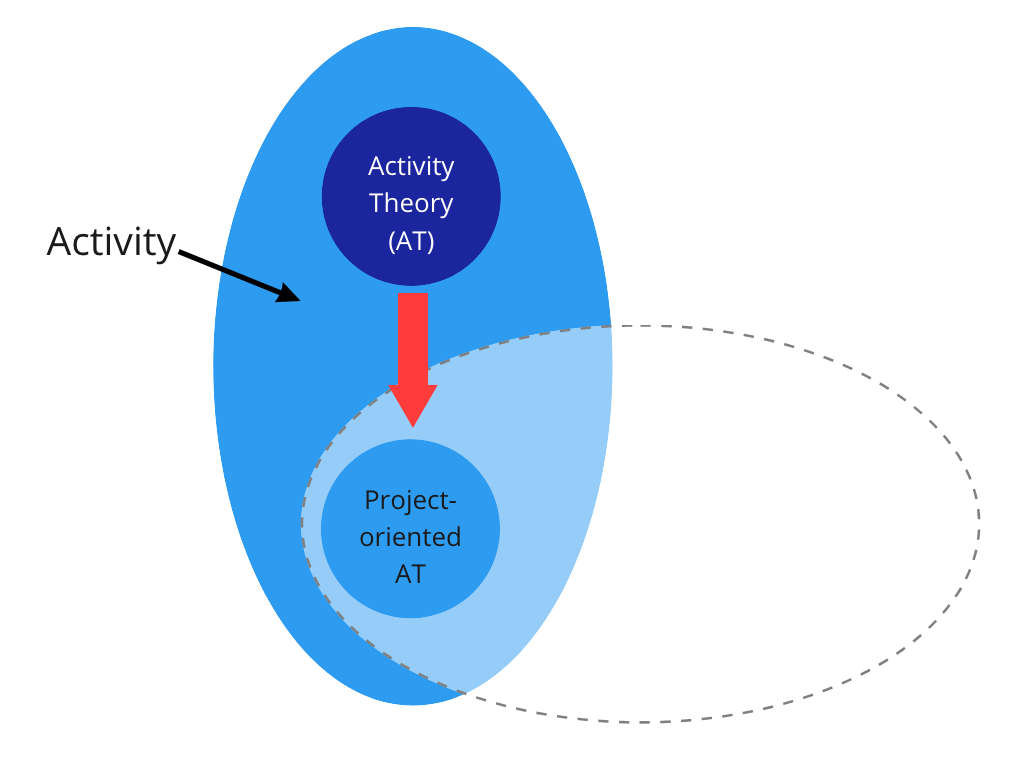
Blunden also adopts Hegel’s logic and Vygotsky’s theory about “Unit of Analysis” and “Concept” as theoretical resources. The process is documented in four books: An Interdisciplinary Theory of Activity (2010), Concepts: A Critical Approach (2012), Collaborative Projects: An Interdisciplinary Study (2014), and Hegel for Social Movements (2019).

What Blunden suggested are that 1) We can use “Project” as a new unit of analysis for Activity Theory, 2) Project should be understood as "Formulation of Concepts", and 3) The archetypal unit of “Project” is two people working together in a common project.
Andy Blunden doesn’t use “Project-oriented Activity Theory” as an official name for his approach. Originally, I used this term to refer to Blunden’s approach. Later I realized that the name becomes an issue because my articles present my interpretation of Blunden’s approach. You can find more details in Project-oriented Activity Theory (Book).
I designed a series of diagrams for Andy Blunden's approach. I also developed two concepts for the book. See the canvas below.
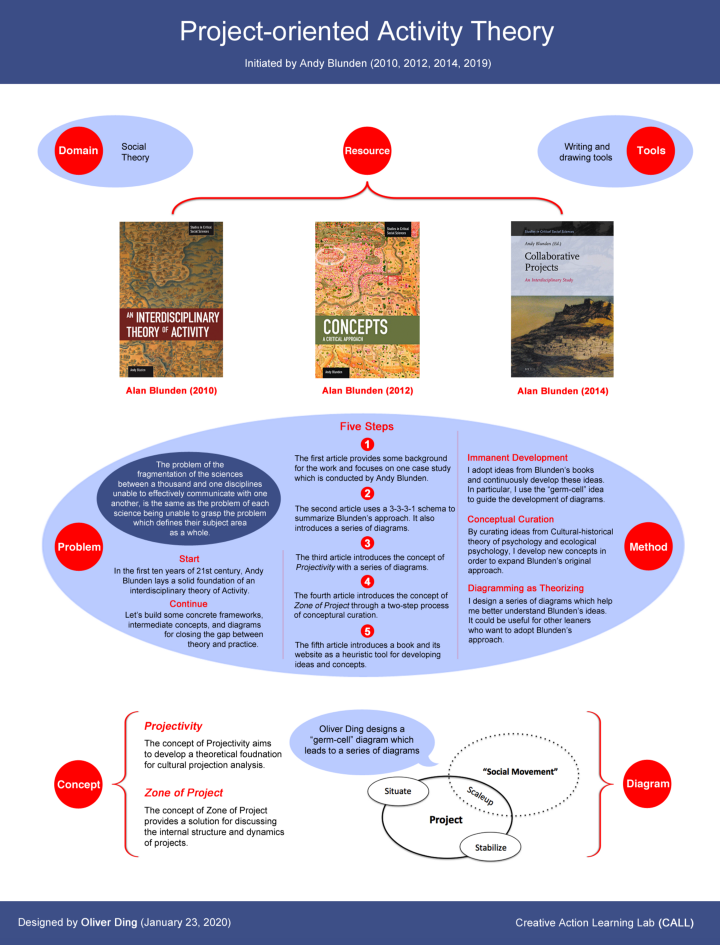
The most important difference between Blunden’s original approach and my interpretation is that his vision is to develop a general interdisciplinary theory of Activity as a meta-theory. However, my vision is to adopt his meta-theory and develop some frameworks and models for practical studies. Also, my focus is on knowledge works and knowledge workers.

The above diagram is one of the diagrams I designed for Andy Blunden's approach.
You can find more diagrams in Case Study: TEDx as "Formation of Concept" [Activity Theory].
4. Making Curativity Theory
On the other side, I worked on developing the Ecological Practice Approach which is inspired by Ecological Psychology.
In 2019, I had wonderful various epistemic activities. I wrote a book for my favorite topic Curation and developed a theory called Curativity Theory.
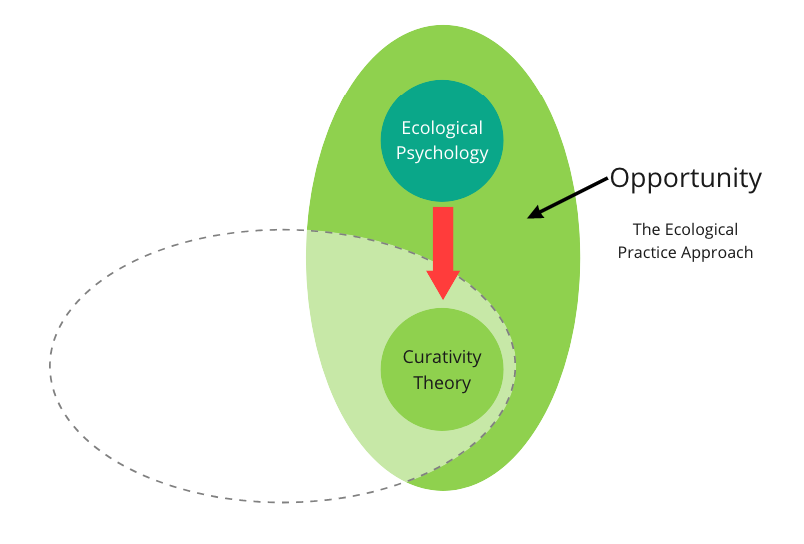
I have worked in the curation field for over ten years. I was the Chief Information Architect of BagTheWeb.com which was an early tool for content curation (We launched the site in 2010). This experience inspired me to make a long-term commitment to the Curation theme. After having 10 years of various curation-related practical work experience and theory learning, I coined a term called Curativity and developed Curativity Theory which became a book.
You can find more details in Curativity Theory: Table of Contents and Related Articles.
The core idea of Curativity Theory is very simple:
In order to effectively curate pieces into a meaningful whole, we need Container as part to contain pieces and shape them.
The theory built a brand new ontology called “Whole, Piece and Part” and adopted James Gibson’s “Affordance”, George Lakoff’s “Container” and Donald Schön’s “Reflection” as epistemological tools. To test the theory, I wrote several case studies and one of them is titled Knowledge Curation.
In 2020, I started the Knowledge Curation project and worked on making new knowledge containers such as frameworks, models, diagrams, and canvas.

The above picture shows a set of meta-diagrams I made in the past several years. You can find more details in Diagram Blending: Building Diagram Networks (Introduction).
5. Switch between Host and Guest
Now we can move to the next stage and host a creative space for a thematic dialogue.
This strategy is based on the WXMY diagram and the Echozone model. See the diagram below.

The above model shows three containers and the middle container is also called Echozone which is the first aspect of the WXMY diagram.
The concept of Container is the core of the Ecological Practice approach. By adjusting the quality and quantity of the Container, we can create advanced frameworks for discussing complex phenomena. The quality of the Container can be potential and actual, and the quantity of the Container can be one or two. If we develop a new framework with one potential container and two actual containers, the outcome is the above diagram.
I named the potential container (Container Z) Echozone which refers to a creative space containing echoes between Container X and Container Y. The term “Echo” of “Echozone” refers to a dialogue between two containers.
You can find more details in The Knowledge Curation Toolkit #2: WXMY for Interdisciplinary Curation.
The Echozone is the creative space for engaging with a theory or developing dialogue between two theories. For my journey of "Activity - Opportunity" Thematic Dialogue, I didn't directly work on the dialogue. What I did is maintaining the boundary of both Activity Theory and Ecological Psychology.
6. Guests: "Affordance" and "Ecological Zone"
In Jan 2021, I worked on developing the Project Engagement (v1.0) framework for Project-oriented Activity Theory. I used the concept of "Projectivity" which is inspired by Ecological Psychology to develop Andy Blunden's approach to Activity Theory. I also used the concept of "Ecological Zone" to develop the concept of "Zone of Project" for the Project Engagement (v1.0) framework. See the diagram below.
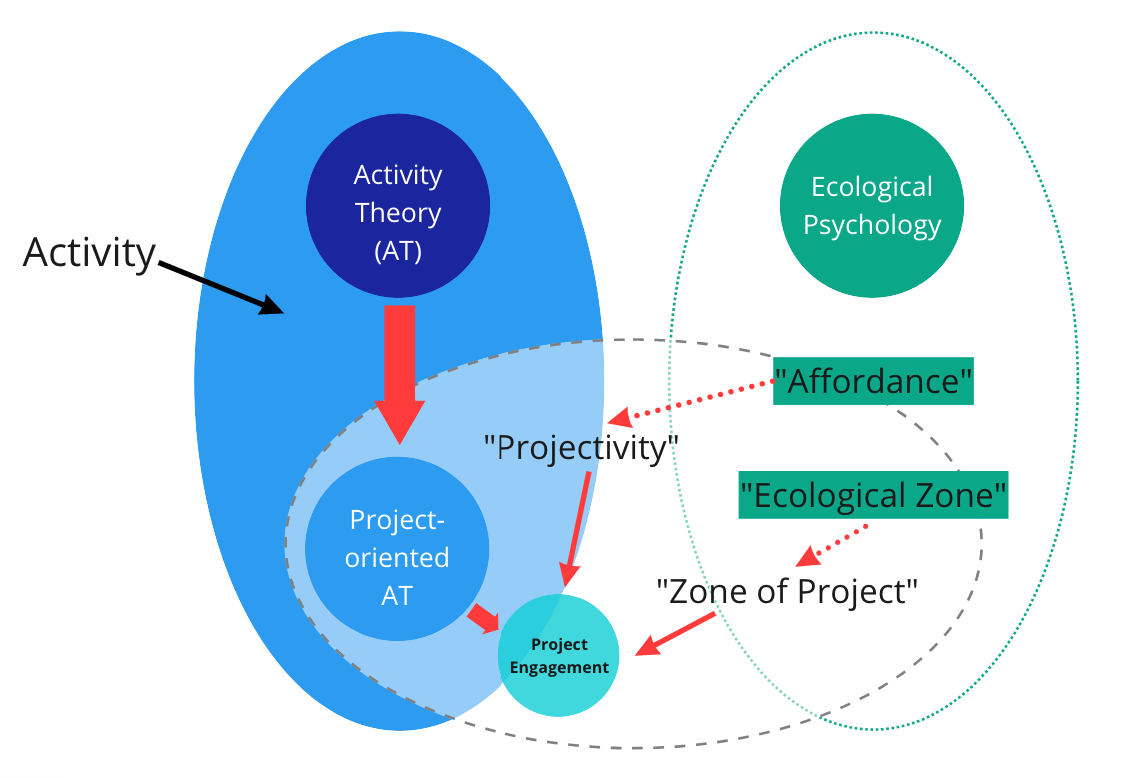
The Concept of “Projectivity” is inspired by Ecological Psychologist James J. Gibson’s Affordance Theory and Andy Blunden’s Project-oriented Activity Theory. The chart below presents three similar concepts: Affordance, Supportance, and Projectivity. Both three concepts share the same deep structure: the Reciprocal Relationship between Environment and Organism. For the Platform-for-Development framework, we can consider Platform as Environment. For Project-oriented Activity Theory, we can consider Project as Environment.

What’s Projectivity? It refers to potential action opportunities of forming a project or participating in a project for people to actualize their development with others.
The concept of Projectivity connects Project, Projecting, and Projection together and can be used as a foundation for Cultural Projection Analysis which is a method of the Project Engagement (v1.0) framework.
Andy Blunden mentions the origin of a project in the 2014 book Collaborative Projects: An Interdisciplinary Study. He says, “What distinguishes Activity Theory from Phenomenology and Existentialism is that for Activity Theory, the project has its origin and existence in the societal world in which the person finds themself; for Phenomenology and Existentialism the psyche projects itself on to the world. For Activity Theory, commitment to a project and formulation of actions towards it, are mediated by the psyche, but a project is found and realized as something existing in the world, be that an entire civilization, a single personality, or anything in between. (See MacIntyre, 1981, p.146)” (2014, p.7).
Based on Blunden's ideas, I designed a set of diagrams to develop the method of Cultural Projection Analysis. The diagram below is one of these diagrams.

The Primary Projectivity starts from the above message, especially the important statement “…a project is found and realized as something existing in the world…”. Inspired by Ecological Psychology, I define the “…something existing in the world…” as Primary Projectivity which is offered by the social/cultural environment and refers to potential action opportunities for initiating a brand new Project.
The above diagram represents the spatial logic of Primary Projecting. A person perceives and knows a projectivity offered by Society through the sense-maker Events. Then the person actualizes the projectivity by formulating actions. The outcome is a brand new project is initiated and the person moves his position from outside space to inside space. By changing his position, the person became a participant in the project as the founder or initiator of the project.
You can find more details in Activity U (X): Projecting, Projectivity, and Cultural Projection.
In order to understand the internal structure and dynamics of Projects, I proposed the concept of Zone of Project which is inspired by Lev Vygotsky’s Zone of Proximal Development and Roger Barker’s Behavior Settings theory.
As an important step in expanding the approach of Project-oriented Activity Theory, I run a complex conceptual curation to produce the concept of the “Zone of Project”. See the diagram below.

There is an indirect connection between Cultural-historical psychologist Lev Vygotsky and Ecological Psychologist Roger G. Barker.
In fact, we can find a direct connection between Vygotsky and Barker in the development of Activity Theory and CHAT (Cultural-historical Activity Theory). One of the leading scholars of CHAT is Michael Cole who aims to bridge the Cultural-historical Psychology and American Anthropology. Michael Cole is a student of Alexander R. Luria who is one of the founders of Cultural-historical Psychology and a leader of the Vygotsky Circle also known as “Vygotsky-Luria Circle”.
Michael Cole echoes Barker’s idea in his 1996 book Cultural Psychology. In particular, he writes about “Context/Practice/Activity and Ecological World Views” and encourages readers to embrace ideas from ecological psychologists.
Following Cole’s strategy, it is possible to expand Project-oriented Activity Theory with the new concept of “Zone of Project” which is originally inspired by Bark Roger’s Behavior Settings theory.
You can find more details in Activity U (XI): Process, Position, and Zone of Project.
7. Guests: "Concept" and "Formation of Concepts"
On the other side, I worked on the Platform Ecology project which is part of the Ecological Practice Approach.
In March 2021, I wrote a book titled Platform for Development: The Ecology of Adult Development in the 21st Century. On March 24, 2021, I introduced the Concept-fit framework for understanding Platform Innovation.
The term “Concept” is adopted from Project-oriented Activity Theory which considers an activity as a process of formation of a brand new concept. The "Concept-fit" framework is a sub-framework of the Platform-for-Development (P4D) framework. See the diagram below.
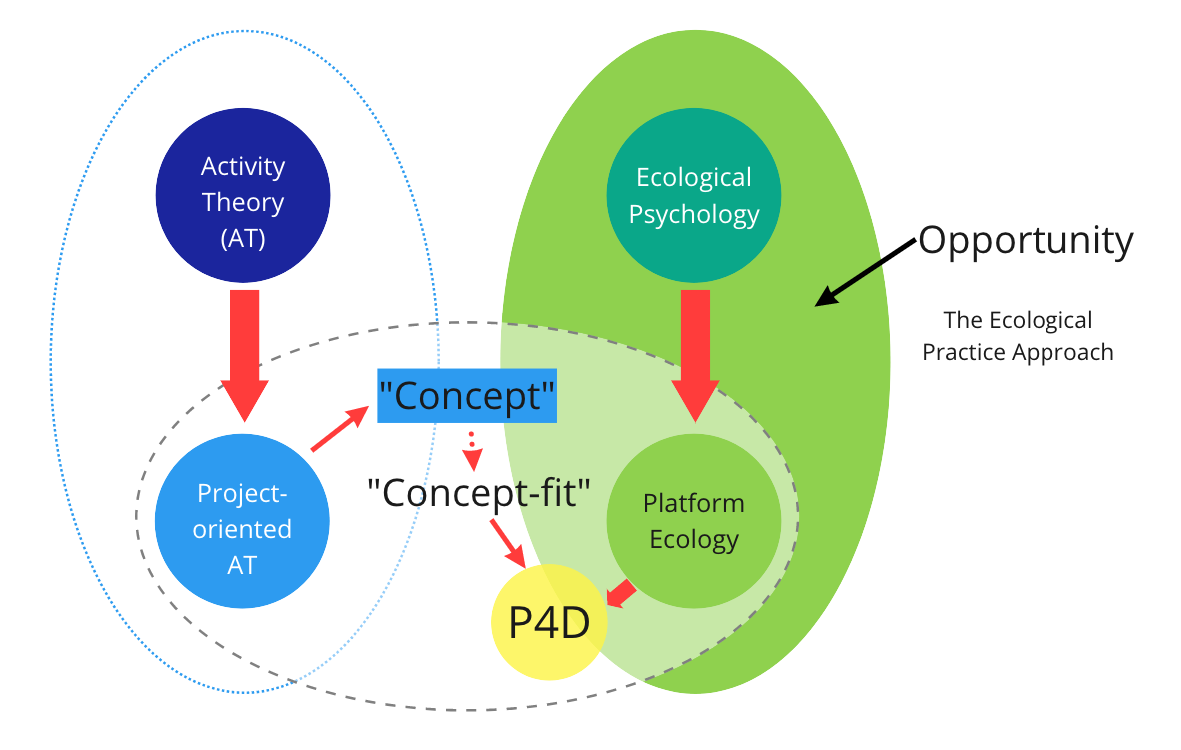
The term “Concept-fit” means six types of concepts fit together from two sides and three levels.
- Technological concepts at the Theoretical level
- Technological concepts at the Operational level
- Technological concepts at the Product level
- Sociocultural concepts at the Collective level
- Sociocultural concepts at the Individual level
- Sociocultural concepts at the Project level

The distinction between Technological concepts and Sociocultural concepts corresponds to the distinction between Natural science and Social science/humanities. Thus, socio-cultural concepts refer to any non-technological concepts including political concepts and economical concepts.

Readers may argue that this is an oppositional dualism: the nature-culture divide. However, it is better to consider the above U diagram as a spectrum. We should think about nature and culture as part of the spectrum as a whole. Moreover, I adopt Hegel’s theory of Concept for understanding these three levels. It offers a great approach to thinking dynamic process of fit between nature and culture.
You can find more details in Platform Innovation as Concept-fit.
8. Second-wave Development
There is a significant movement in my journey of "Activity - Opportunity" Thematic Dialogue.
I didn't plan to run the thematic dialogue. I worked on the second-wave development of Curativity Theory and Project-oriented Activity Theory separately. See the diagram below.

I finished the draft of the book Curativity in March 2019. The concept of "Themes of Practice" is a core idea of Curativity Theory. The purpose of the concept is to connect “life theme” and “culture theme”.
In August 2021, I returned to the concept of "Themes of Practice" and works on Career Themes focusing on the “Practice” part of “Themes of Practice.” This experience inspired me to review the historical development of the idea of “Themes of Practice”. I collected all my writings about Themes of Practice in past years and edited a Table of Content for a possible book. To my surprise, I have written over 440 pages about the idea of “Themes of Practice”.
You can find more details in Themes of Practice (2019–2021).

On the other side, I finished the draft of the book Project-oriented Activity Theory in Jan 2021.
In July 2022, I developed some new sub-frameworks for the Project Engagement approach. On August 2, 2022, I launched v2.1 of the approach. You can find more details in Project Engagement (v2.1) as an Innovation Approach.

These activities are second-wave development of my work. In this stage, I realized several "ECHOes" between the two approaches.
9. "Themes of Practice" in 2021
I started developing the concept of Themes of Practice in 2019 for Curativity Theory.
In 2021, I applied the concept of Themes of Practice to Career Curation. This is the second-wave development of the concept.
In April 2021, I started learning Genre Theory. I designed a new diagram for Themes of Practice and shared it on Twitter for discussing Genre Theory. At that time, I didn’t realize that the new diagram offers me a concrete framework for analysis.

In June 2022, I started the Career Curation project. I applied the idea of Themes of Practice to generate a new concept: Career Themes. It means that I move from an abstract level to a concrete level. Thus, I realized I can use the above new diagram for the career theme case study because it offers a structure for observing and evaluating the “Practice” part of “Themes of Practice”.

For example, I chose UX (User Experience) as an example of Career Themes and made a simple case study with the new diagram. See the above diagram.
I called the new diagram "the Themes of Practice Framework". If you pay attention to the diagram, you will find several sub-dimensions. For example, "Concept", "Project", "Activity", etc.
There is an "ECHO" between the Project-oriented Activity Theory and the Themes of Practice framework. See the diagram below.
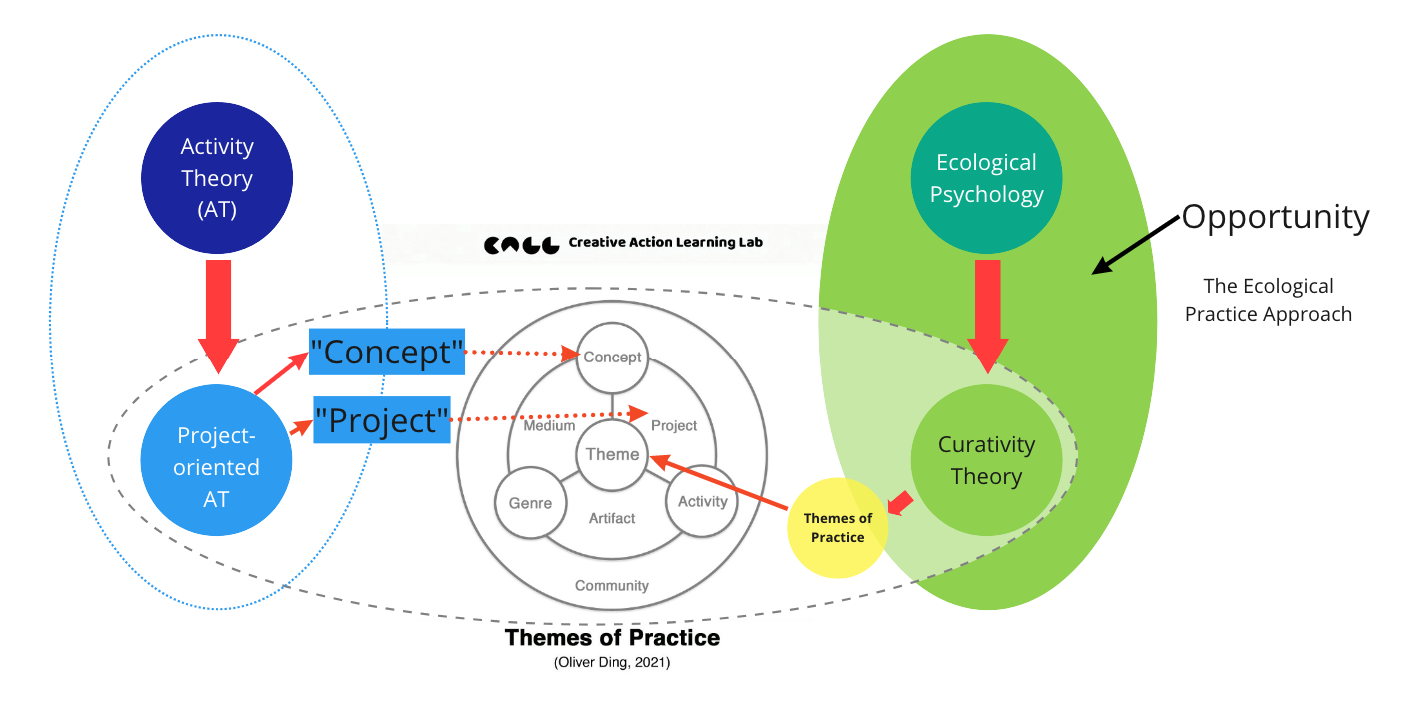
We should notice that I use "Concept", "Project" and "Activity" as Operational Concepts for the Themes of Practice framework. However, I also used Concept Theory, Activity Theory, and Project-oriented Activity Theory as theoretical resources for the framework.
This is an Echo between the two approaches.
10. "Project Engagement" in 2022
Initially, I used the term “Project Engagement” to name the second part of my 2020/2021 book Project-oriented Activity Theory which introduces Andy Blunden’s “project as a unit of analysis of activity” to Activity Theory. I used “Project Engagement” to refer to the “Person — Project” relationship. Why does a person start or join a project? What does a project look like?
From Jan 2022 to June 2022, I worked on testing Project Engagement (v1.0) and realized that I should expand it to the “Project — Project” relationship. Later, I used the idea of “Genidentity” to discuss the transformation from a theme to a project, then a platform. How does a project keep its uniqueness?
In July 2022, I wrote a 116-page file that introduces the Project Engagement approach (v2.1). I used the following three keywords to organize the file.

The term "Significance" refers to v1.0, the term "Complexity" refers to v2.0, and the term "Genidentity" refers to v2.1.
The term "Genidentity" refers to the transformation from a theme to a project, then a platform. How does a project keep its uniqueness?
This idea is a Significant Insight because I realized that I can detach the Platform Genidentity framework from the Platform Ecology project, and attach it to the Project Engagement approach.
See the diagram below.
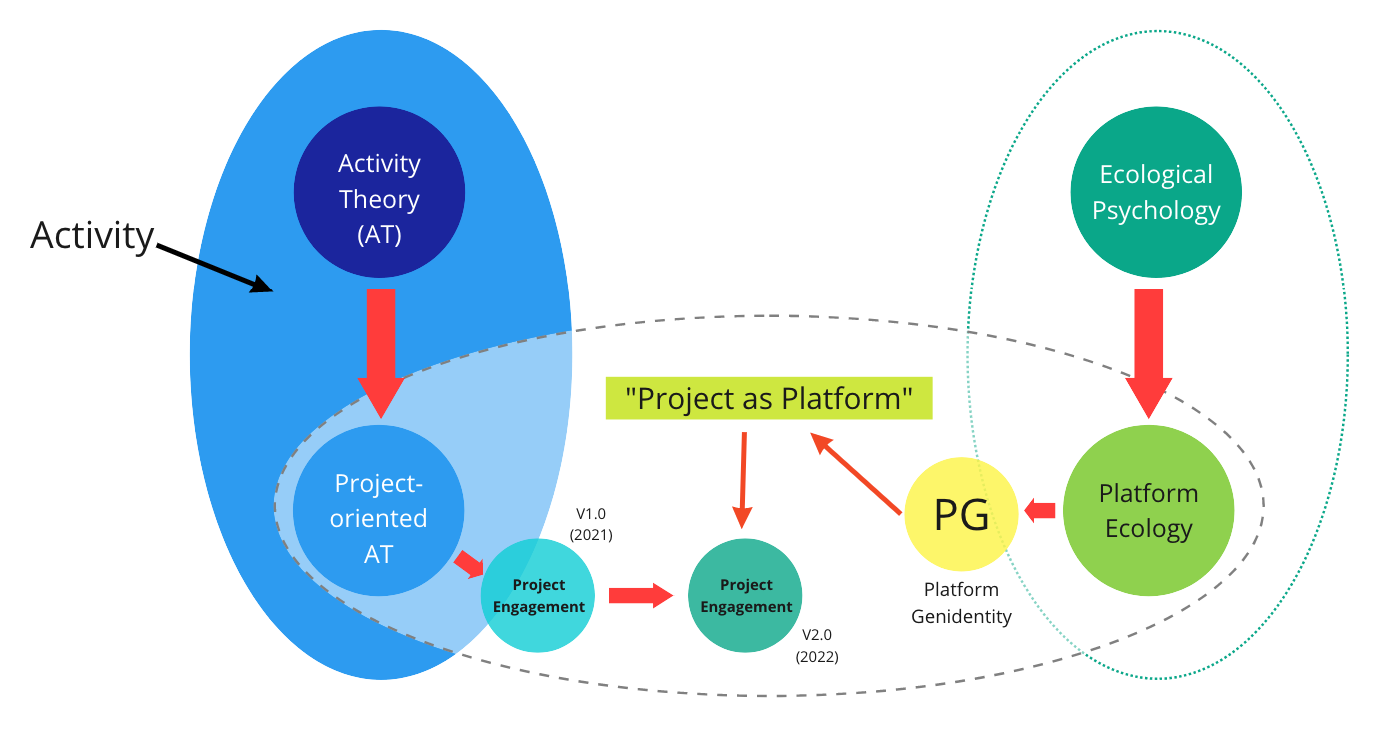
I used the notion of "Platform(Project)" for the Platform-for-Development framework in 2021. It means a platform is an environment of projects.
The notion of "Project as Platform" refers to a new meaning: some projects will grow into large-scale platforms.
Originally, the Platform Genidentity framework is used for describing the path from project to platform. From the perspective of Project Engagement, I can consider the framework as a part of Project Engagement.
This is an Echo between the two approaches two.
11. Close A Thematic Dialogue
On Sept 15, 2022, I launched the Thematic Engagement Toolkit (v1.0) and officially announced the thematic dialogue between the two approaches.
The dialogue between "Themes of Practice" and "Project Engagement" is an example of the dialogue between my "Activity" thematic space and my "Opportunity" thematic space.
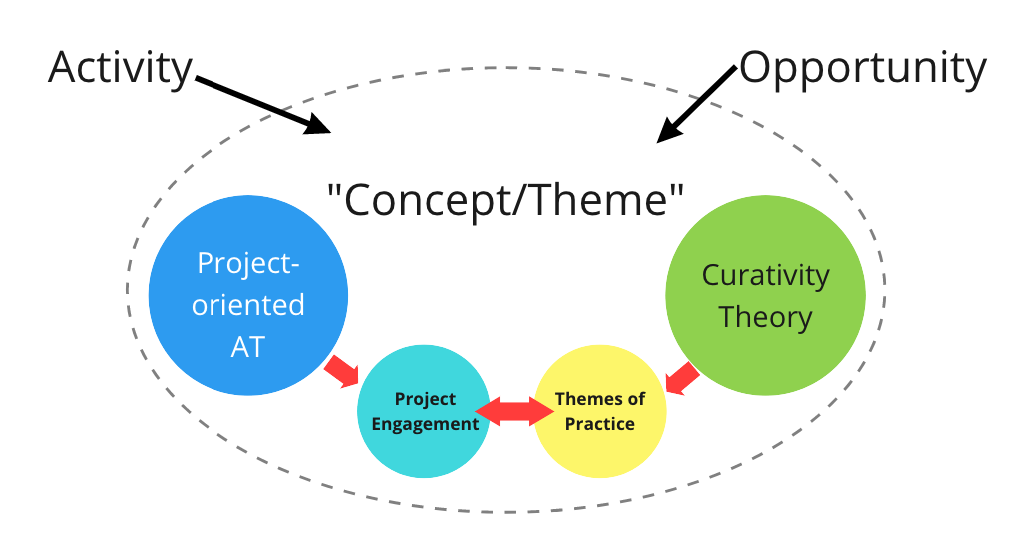
As discussed above, both my "Activity" thematic space and my "Opportunity" thematic space are large-scale cognitive spaces. They contain different levels of ideas. Thus, there are many possibilities for thematic dialogues.
Finally, the Project Engagement approach (v2.1) builds a multiple-level framework. You can find "Platform" as a level for analysis.

While the term "Platform" refers to "Project as Platform" and the Platform Genidentity framework, it can connect to the Platform Ecology project too.
Now we see a new thematic dialogue: the "Project - Platform" Thematic Dialogue.
